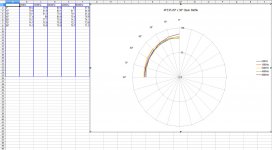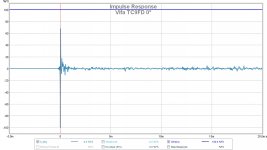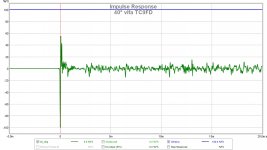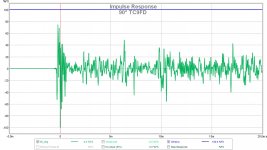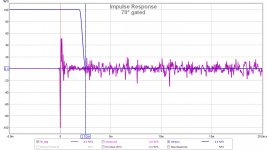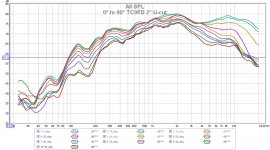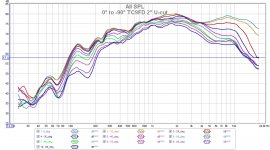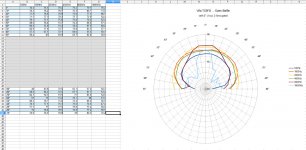Super massive cool stuff... thanks Rudolf and Z 
As an aside, it looks like I'm stuck at a max -50dB THD on both the OB, sealed mMarS and FH3 enclosure. Still want to try the A7.3 on an OB to see if the distortion figures improve once free from a box.
From peoples experience, what kind of THD levels are realistically possible at 80 to 85dB [not accounting for the room or with an acoustically treated room]?
As an aside, it looks like I'm stuck at a max -50dB THD on both the OB, sealed mMarS and FH3 enclosure. Still want to try the A7.3 on an OB to see if the distortion figures improve once free from a box.
From peoples experience, what kind of THD levels are realistically possible at 80 to 85dB [not accounting for the room or with an acoustically treated room]?
FC is fun to play with and now I have a pair of TC9FD's may try a few of the builds out ... DCR and Nautaloss being the main two and maybe the Mini Karlsonator
|-O-|
Finally fitted the Alpair 7.3 into the Plant 10 designed mMarS sealed enclosure, needed to play around with the filling to try smooth out one or two peaks & more tweaking still required. The FR is quite nice and THD fairly good but could be better...
A7.3 measure very close in both the mMarS and FH3 ... the measurements of the 4FE35 so far have proved slightly better for the same SPL... Would like to try the A7's mounted on an OB at some point.
One area I'm not happy with is the A7.3's IR, the second period of peaks looks to be from internal reflections? Certainly not as clean a response as with the OB's
For a foam desktop computer speaker what might you recommend. I don't mind it being significantly bigger than a computer speaker but wouldn't want it to be bigger than a bookshelf speaker.
Bojonjovi,
For a desktop speaker that is a manageable size and sounds good I recommend the 0.4x mini Karlsonator with a single Vifa TC9FD. It is 12 in tall x 6.25 in wide and gets about 75 Hz bass extension.
http://www.diyaudio.com/forums/full-range/239338-mini-karlsonator-0-53x-dual-tc9fds.html
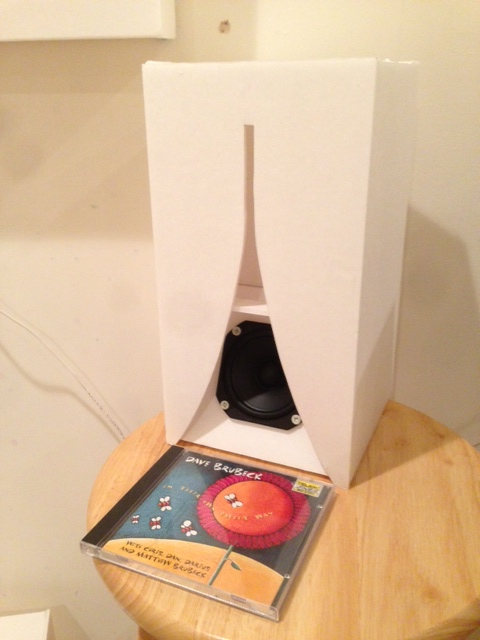
For a desktop speaker that is a manageable size and sounds good I recommend the 0.4x mini Karlsonator with a single Vifa TC9FD. It is 12 in tall x 6.25 in wide and gets about 75 Hz bass extension.
http://www.diyaudio.com/forums/full-range/239338-mini-karlsonator-0-53x-dual-tc9fds.html

I don't think you will get much better than -50dB HD at 85dB. That is an impressive figure already. What I think will be good is to reduce distortion in bass below 200 Hz to -40 dB or below.
Thanks X, I have a plan
A simplified variation of SL's LX521 design... simplified as I'd like to use just use a single FR unit [no tweeters] with the 8" lower-mid driver and then duel 10" in a W-frame or the Alpha 15A in a H-frame... thinking XO at ~300Hz and ~70Hz.
Starting point will be the Mark Audio A7.3. Not sure on the 8" woofer yet, maybe the Peerless 830869 HDS 205 NOM or something from the Scanspeak discovery range.
|-O-|
Being a cheap-skate, I'm exploring the possibility of creating the polar plots by hand... measure with REW and export the date [manually] into a spread-sheet and generate the plots that way!? Can REW gate the IR in the way ARTA can?
Looks nice Paul. Expand the polar radial axis to 50 to 100 dB so we came resolve variations. I like your plan for simplified LX521. Full range on top will probably be better with 4FE35 based on what you have shown so far as it has better sensitivity and looks smoother and lower HD. The 8 in go with Peerless or Silver Flute wool cone woofer. Instead of W frame do slot OB with dual 10 in - I think SL has that as horizontal a lot loaded sub.
I think what may have kept a lot of folks away from a SL LX531 style system was all the electronics involved with the ASP. Now with an $80 miniDSP 2x4 in vertical integration mode and two class d amps you can get 4 channels of active XO per left or right side. So get two 2x4 miniDSP rather than one 2x8 minDSP because it is cheaper.
Cost of two miniDSP 2x4 and four tpa3116's is $240 plus $10 for the advanced 1x4 XO plugin. $250 total for all electronics including amps.
Qnty 2 4FE35 at $50, qnty 2 8 in wool cone woofers for $60, qnty 4 10 in woofers at $250.
Total system price not including wood is under $600.
I think what may have kept a lot of folks away from a SL LX531 style system was all the electronics involved with the ASP. Now with an $80 miniDSP 2x4 in vertical integration mode and two class d amps you can get 4 channels of active XO per left or right side. So get two 2x4 miniDSP rather than one 2x8 minDSP because it is cheaper.
Cost of two miniDSP 2x4 and four tpa3116's is $240 plus $10 for the advanced 1x4 XO plugin. $250 total for all electronics including amps.
Qnty 2 4FE35 at $50, qnty 2 8 in wool cone woofers for $60, qnty 4 10 in woofers at $250.
Total system price not including wood is under $600.
Last edited:
As you say, with the miniDSP and tpa3116's it makes that style and others more accessible 
Like the idea of the slot loaded OB with twin 10"... plus, have heard a few good things about the Silver Flute wool cone woofers. At the current exchange rates it'd be worth importing a couple.
Have adjusted the chart's axis to read 50, 75, 100, plus set it to 10° segments... Hope to do the first set of measurements with the Vifa & test baffle tomorrow if I have time before work... certainly Tuesday if not.
Like the idea of the slot loaded OB with twin 10"... plus, have heard a few good things about the Silver Flute wool cone woofers. At the current exchange rates it'd be worth importing a couple.
Have adjusted the chart's axis to read 50, 75, 100, plus set it to 10° segments... Hope to do the first set of measurements with the Vifa & test baffle tomorrow if I have time before work... certainly Tuesday if not.
Nice and fast work, BMSHad a very quick 20 minute play with Open Office spread sheets to generate a polar plot.

Just to give you a perspective I add three iterations of showing a polar data set with Arta:
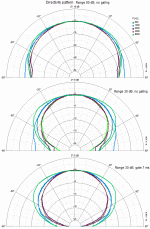
Top is a wide dB span as in your spreadsheet. Even at 80 dB span you don't see much of a figure 8.
The diagram in the middle is at 30 dB, which is what most everybody does - an improvement in judging the dipole pattern.
At the bottom the impulse response is gated for a 7 ms window. Now the polars are increasingly free from room reflection artefacts, especially at +60° angles.
Thanks Rudolf, just figured out how to Gate the IR within REW. With the data used for the 0° to 90° 4FE35 polar plot, looks like first room reflections hit at just over 5ms. So a 5ms window should be used.
As you suggested, once I've done a run of axial measures, I'll post 0°, 45° and 90° IR and we can decide on the gating to be used.
As you suggested, once I've done a run of axial measures, I'll post 0°, 45° and 90° IR and we can decide on the gating to be used.
Bojonjovi,
For a desktop speaker that is a manageable size and sounds good I recommend the 0.4x mini Karlsonator with a single Vifa TC9FD. It is 12 in tall x 6.25 in wide and gets about 75 Hz bass extension.
http://www.diyaudio.com/forums/full-range/239338-mini-karlsonator-0-53x-dual-tc9fds.html

That looks like somthing I would be very interested in. Let me check that out a bit and review plans?
And hey,
Thanks!
Last edited:
Foam Core ?
What should I be asking for and what thickness?
BJJ
Where should I go to find Foam Core. Big box, upholstery shop, flea bay?That looks like somthing I would be very interested in. Let me check that out a bit and review plans?
And hey,
Thanks!
What should I be asking for and what thickness?
BJJ
Dollar stores (Dollar Tree, Dollar General, etc.) have them for $1 ea. They come in 3/16 in thick 20x30 in. This stuff is very lightweight and useful for smaller projects or for curved surfaces. There is Elmer's brand at art stores or craft stores (Michaels') that has thicker paper walls but is still 3/16 in thick. Those cost about $3 to $4 ea and are good for bigger projects or for more durable stuff. The min Karlsonator uses the $1 store stuff. IIRC it uses a single sheet per speaker, but buy a bunch in case you mess up or for future projects. You will also need hot melt glue and gun.
Nice and fast work, BMS
Just to give you a perspective I add three iterations of showing a polar data set with Arta:
View attachment 410921
Top is a wide dB span as in your spreadsheet. Even at 80 dB span you don't see much of a figure 8.
The diagram in the middle is at 30 dB, which is what most everybody does - an improvement in judging the dipole pattern.
At the bottom the impulse response is gated for a 7 ms window. Now the polars are increasingly free from room reflection artefacts, especially at +60° angles.
I just wanted to say that I really appreciate you, BMS, and Z in supporting this thread and expanding it to the intricacies of polar directivity with inexpensive drivers in an OB. This is really good stuff you guys are posting and I am not sure it is on any other thread! Thanks.

Attachment
Is the foam board stiff enough to support the drivers over time or do you do something to stiffin the face up? What type nuts/bolts do you use for attachment of drivers; same as wood?
Dollar stores (Dollar Tree, Dollar General, etc.) have them for $1 ea. They come in 3/16 in thick 20x30 in. This stuff is very lightweight and useful for smaller projects or for curved surfaces. There is Elmer's brand at art stores or craft stores (Michaels') that has thicker paper walls but is still 3/16 in thick. Those cost about $3 to $4 ea and are good for bigger projects or for more durable stuff. The min Karlsonator uses the $1 store stuff. IIRC it uses a single sheet per speaker, but buy a bunch in case you mess up or for future projects. You will also need hot melt glue and gun.
Is the foam board stiff enough to support the drivers over time or do you do something to stiffin the face up? What type nuts/bolts do you use for attachment of drivers; same as wood?
Is the foam board stiff enough to support the drivers over time or do you do something to stiffin the face up? What type nuts/bolts do you use for attachment of drivers; same as wood?
I just use normal wood screws in my foamboard builds. You may want to attach a small block of wood behind where the screws go to provide something for them to bite into or another layer of foamboard.
If you find that the screw has become loose in the foamboard, i.e. from removing the driver for tweaking the stuffing etc. too many times, you can always remove it and fill the hole with a little hot melt glue to form new material for the screw to bite into.
Your very welcome X... 
Whoop! First set of measures completed and have a few screen grabs from REW:
-- 0° IR
-- 40° IR
-- 90° IR
-- 70° IR with 2.5ms right gate
-- 0° to 90° FR, 1/3 smoothing ... Vifa TC9FD, 2" U-cut OB
-- 0° to -90° FR 1/3 smoothing ... Vifa TC9FD, 2" U-cut OB
If we think 2.5ms is OK for the right gate, I'll proceed with producing the polar plot.
Whoop! First set of measures completed and have a few screen grabs from REW:
-- 0° IR
-- 40° IR
-- 90° IR
-- 70° IR with 2.5ms right gate
-- 0° to 90° FR, 1/3 smoothing ... Vifa TC9FD, 2" U-cut OB
-- 0° to -90° FR 1/3 smoothing ... Vifa TC9FD, 2" U-cut OB
If we think 2.5ms is OK for the right gate, I'll proceed with producing the polar plot.
Attachments
Last edited:
And the polar plot of +90° to 0° to -90°, with a 2.5ms right gate...
Setting up and measures took roughly 1hr, preparing the data and plots, about the same...
If 80dB SPL is to low, I can re-do this set before I make the next cut on the U-shape.
Setting up and measures took roughly 1hr, preparing the data and plots, about the same...
If 80dB SPL is to low, I can re-do this set before I make the next cut on the U-shape.
Attachments
Last edited:
- Home
- Loudspeakers
- Full Range
- Cheap and FAST OB, Literally
